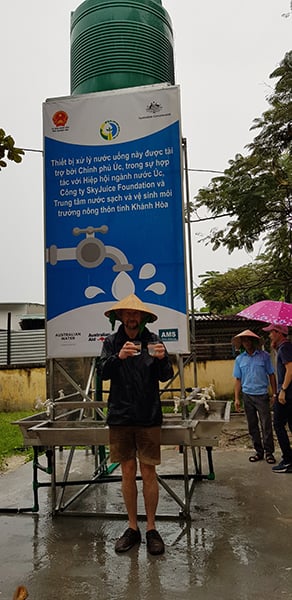Private sector participation in the water sector
By M Woolston, S Saris and P Smith.
First published in Water e-Journal Volume 3 No 1 2018.
Abstract
Governments throughout the world have been using public private partnerships (PPPs) over the past 20 years for three key reasons. First, PPPs have been effective in helping governments respond to the increasing demand for infrastructure-related services. Second, by shifting the burden of capital spending to the private sector, PPPs can help governments do more with less. Third, PPPs contribute to enhanced efficiency in delivering services.
PPPs are not, however, the answer to all infrastructure or public service shortcomings. Successful PPPs require careful risk allocation and a strong enabling environment, which are a challenge to achieve. In addition, most PPP failures arise from poor contract preparation, inadequate risk allocation, the absence of competitive and transparent tendering procedures, and poor contract monitoring and enforcement systems.
There are a wide range of approaches for enhanced private sector participation in water which have been commonly used around the world in different circumstances. Experience has been mixed: there has been considerable success but also many examples where desired outcomes have not been achieved.
The purpose of this paper is to set out the scope and range of PPP models, to aid in the selection of the most appropriate form of PPP and set out options for optimal risk allocation for enhanced private sector participation.
Public private partnerships – an introduction
A public private partnership (PPP) is a contractual arrangement between the government and the private sector, where the private sector provides a good or service for or on behalf of the government.
The key features of a PPP include the provision of a service, which may entail the private company completing all steps of development and operation of an asset, or it could involve the private company taking over an asset and continuing its operation. Secondly, there is a government contribution, either through land, capital works, risk sharing, revenue diversion, purchase of the agreed services, or other supporting mechanisms. Another key feature of a PPP is that there are payments to the private sector from the government or users, in return for their provision of the service (Menzies, 2016).
PPPs are being used more often in developing countries to help governments meet the clean water needs of the growing population. Clean water provision in itself is capital intensive and often requires skills or expertise in that area to make it sustainable and efficient. In both cases, partnering with a private firm who has capital and knowledge in the water sector, aids the government in providing these essential services. Essentially, PPPs can be beneficial as they allow access to both greater capital and skills in a given sector whilst allowing the government to share some of its risks.

Types of PPPs – sharing of responsibilities
There are a wide range of PPPs available, all of which reflect the functions that the private and public sectors are expected to undertake and the extent to which the private sector owns/operates the asset. The above diagram has been taken from Menzies (2016) and details the main types of PPPs, alongside a high-level assessment of the extent to which each party owns/operates the asset.
Contract options on the left are essentially wholly owned by the public sector, and as such, there is very little private sector participation. The first three options – utility restructuring, corporatisation and decentralisation – generally only involve knowledge transfer and no operation of the asset. The following two options – civil works and service contracts – generally entail the purchase of goods, or the procurement of civil works, such as the laying of pipes or cables, which will be used in the asset (World Bank, 2017).
The options in the middle of the diagram involve a greater degree of private and public partnership, as opposed to those on the extremities. These contracts, under the heading of “public private partnership”, will be the focus of the following discussion.
Types of PPPs – length of contract
PPP contracts not only vary depending on the sharing or assignment of responsibilities, but also vary depending on length of contract and whether the asset needs to be built or not.
The below diagram from Delmon (2014) shows a spectrum of PPPs, however, the spectrum is a combination of length and private/public responsibility. For example, we would expect a design-build type contract to be a very short-term project, with little private responsibility, whereas a build-own-operate contract would be lengthy, and have little public responsibility.
It should also be noted that contracts above the arrows are “new projects”, or “greenfield projects”, which means that all of these contract types generally entail the construction of an asset. For contracts beneath “existing services and facilities”, or “brownfield projects”, the asset already exists and the private sector is more likely to take over control from the government.

Common PPP contracts for existing assets
Management contract
A private operator is appointed by the government to run the pre-existing assets and staff. In return the government pays the operator a fee (which is performance based). The operator maintains no responsibility for additional investment into the assets over the contract life.
Operation and Maintenance (O&M) contract
Similar to a management contract, the operator operates the asset in return for a performance-based fee from the government. The operator has greater control over the asset and can bring their own staff. The operator may be responsible for more repair and renewal obligations as opposed to under a management contract. However, these responsibilities are still limited.
Affermage contract
Under an affermage contract, the operator supplies customers within a given area. This contract involves responsibilities similar to those of an O&M contract. Revenue and the operator’s fee is derived from tariffs, anything in excess of the operator’s fee is paid to the authority for reinvestment. The authority still owns the asset, and is responsible for all major repairs, renewal and expansions.
Lease contract
The operator pays a fixed lease fee for the right to exploit the asset for a fixed period, this fixed fee is intended to compensate the government for their capital costs, but also exposes the operator to extensive revenue risks. The operator carries extensive repair and renewal obligations and may also be required to make capital investments.
Common PPP contracts for new build, expansion or rehabilitation projects
Design-Build-Operate (DBO)
A DBO contract requires the operator to design and build the project, as well as deliver the service. The operator does not typically finance the project as they are paid a lump sum for installation upon commissioning and then a periodic fee for operations. The operator is responsible for construction and operation, and the remaining costs fall upon the authority. Planning responsibilities for future expansion or investment are the responsibility of the operator. However, approval from the authority is needed to proceed.
Design-Build-Lease (DBL)
The operator designs and builds the scheme, which is then sold to the authority who simultaneously leases it back for a fee.
Build-Operate-Transfer (BOT)
A BOT contract involves the operator designing, building, financing and operating a system for the duration of the contract. The operator owns the asset until the contract expires and is remunerated through a volume-based fee, paid by the government.
Build-Operate-Own (BOO)
The BOO contract is similar in its design to a BOT, however, in the case of a BOO contract, there is no transfer back to the government after a given period of time. The private sector permanently remains the operator.
Concession contract
The operator is granted the right to develop and utilise assets for the duration of the contract. On some occasions, the operator pays a concession fee to the government in return. Concession contracts are primarily used for existing assets, but any further development of assets or investment must be financed by the operator. In these cases when there is additional investment, the concessionaire owns the new asset until contract expiry.
Joint venture
The government forms a joint venture with a private operator and the private operator typically buys equity in the joint venture. Within a joint venture, the public sector retains a certain level of control and will be involved in decisions made by the operator. The private and public operators both have control over management decisions, meaning that the private partner can be simultaneously operator and part-owner.
Types of PPPs – detailed description
The following tables provide detail on typical features of each type of PPP contract and their strengths and weaknesses. In practice, however, there may be variations in precise arrangements.


Choosing the right PPP
While PPPs offer significant potential benefits, whether or not these are achieved in practice depends heavily on whether the right form of PPP is selected for the particular project in question and the details of the PPP contract and surrounding legal and institutional framework.
As noted above, there are a vast number of PPP types available. Each PPP allocates responsibilities and risks to different parties, and as such, the choice of PPP can be tailored to the prevailing economic or political conditions in a country. With this being said, the vast choice of PPPs also means that there is potential for a government to choose the wrong PPP, and thus allocate risk/responsibilities to the wrong party, leading to poor outcomes. The considerations that need to be addressed are:
- Identify main areas of responsibility involved in delivering services and the risks associated with each responsibility.
- Allocate functions, responsibilities and risks to the party best able to manage them (i.e. private contractor, procurement authority, customers).
- Design the form of PPP and detailed contractual provisions (including payment methods) to achieve this allocation of responsibilities and risks.
Once these considerations have been addressed, deciding which PPP is suitable under the prevailing circumstances becomes clearer.
A key consideration when designing a PPP contract is the allocation of risk. Correctly assigning potential risks to the correct party is more likely to lead to a successful PPP, whereas incorrectly assigning risk threatens the success of the PPP.
The Asian Development Bank (ADB) highlights the importance of correctly scoping potential risks and a thorough assessment of which party is in the best position to handle the relevant risks (ADB, 2000). They go on to say that risks should be allocated to the party who can minimise and manage the risk most effectively and in the case that neither party be clearly more efficient at managing risk, then risks should be shared.
The various types of PPP models such as those discussed above can be differentiated by the nature and extent of risk transferred to the private sector. For example, a design and build contract transfers only the risks of construction overruns and design to the private sector, whereas for arrangements where the contractor also operates the facility for a period, operations and maintenance risk is also transferred (thus giving a strong incentive for the contractor to optimise any trade-offs between constructions and operation and maintenance costs). Similarly, where ownership remains (at least for the period of the contract) with the contractor, risks related to owning the asset lie with the private sector. Indeed, a PPP is generally seen as being distinguished by the characteristic that the private sector provides the capital assets and the services they generate, and bears the asset-related risks.

Breakdown of risks
This risk breakdown is presented by ADB (2000) and is an example of risks which a privately funded water supply investment may face.
Optimal risk transfer
Having a general idea as to where the risks may fall, and who should handle these risks in a given PPP, leads to the discussion on optimal risk transfer. One of the key reasons why PPPs are beneficial to governments is that they allow them to shift risk to the private sector. This however does not mean that governments can transfer “all” or as much risk as they want. There comes a point where too much risk being allocated to the private sector is detrimental to the success of the project itself.
Menzies (2016) notes that this point of “optimal risk transfer” is conceptual and will be based on the individual characteristics of the government and private contractors involved. It should also be noted that in reality, contracts are generally drawn up based on compromises between the parties involved. The general rule for allocating risk remains the same. Risk should be allocated to the party who can best manage the risk. This means deciding for each risk who can predict the risk, influence the risk, control the impact of the risk, and diversify or absorb residual risk.



Conclusion
There are many different forms of relationship between government and the private sector whereby the resources of the private sector are applied to meet the needs of the public. These involve various combinations of the following functions: Design (D), Build (B), Finance (F), Operate (O), Maintain (M), Own (O) and Transfer (T).
The choice of type of PPP is critical to the likely success of a PPP project – it is therefore vital to thoroughly assess which type of PPP is most likely to be appropriate.
PPPs are about partnerships. In our experience, a government or authority who seeks to push all the risks to the private sector will note their project is not well received and is likely to fail. For example, the private sector is unlikely to take the risk of collecting water rates from end users who are clearly unable to afford the proposed rates.
Finally, a strong enabling environment is crucial. Clear legislation or enabling regulation is a pre-requisite and will encourage investor confidence. The ideal PPP sees competition among private sector participants in both the debt and equity markets, resulting in delivery of high quality public services at the lowest possible cost. Long term undertakings from the public sector (e.g. tariffs, concessions, management fees, etc.) underpin private sector returns and a track record in honouring public obligations will attract further private investment. If the private sector has no confidence that the public sector undertakings will be maintained through the life of the PPP they will add a pricing premium for regulatory risk or, more likely, think twice before participating. A well-developed framework, enabling legislation or regulation and fair risk allocation is necessary to attract private sector investment dollars into infrastructure as many countries increasingly look to compete for private sector capital to deliver their infrastructure needs.
About the authors
Stella Saris is Director, Resources Energy and Infrastructure, South East Asia & India, Australia & New Zealand Banking Group Limited. Stella is a utilities and infrastructure specialist who has worked in Singapore, London and Melbourne. She has over 10 years of project and structured finance experience in both an advisory and lending capacity. For the past eight years, she has been based in Singapore where she has worked with clients in the utilities, renewables, water and transport sectors, financing critical infrastructure across Asia and the Pacific.
Michael Woolston leads Frontier Economics’ water practice in Australia. Michael is an economist with particular expertise in microeconomic and regulatory reform. He specialises in the water and wastewater sector. Michael has led a number of major policy studies in areas including water entitlements and markets, water pricing, institutional and regulatory arrangements in the sector, and resource management issues. He has advised key Australian Government agencies, state and Local Governments, regulators and water businesses. Michael has extensive experience in private sector financing of water infrastructure and has published a number of reports and articles on the scope for greater private sector involvement in the sector. he recently acted as strategic regulatory advisor for Sydney Desalination Plan (SDP), the only privately-owned water supply business in Australia. SDP is jointly owned by the Ontario Teachers’ Pension Plan Board, The Infrastructure Fund (TIF) and Utilities Trust of Australia (UTA). Michael was recently engaged by the Australian Water Association (AWA) to advise on Public Private Partnership (PPP) models and an implementation roadmap for a proposed water treatment plant and water supply pipe network in Nam Dinh Province, Vietnam.
Paul Smith has worked in the water sector for over 20 years within local, state and national governments and more recently the Australian Water Association (AWA). During the 1990’s Paul was the team leader for water cycle management program at Manly Council and also worked with the NSW Government stormwater trust. During the 2000’s Paul delivered the urban water program at the Australian Government National Water Commission. Since 2014, Paul has managed the International Program at the Australian Water Association delivering projects across Asia principally for the Australian Government and the AWA members. Paul has degrees in science and engineering, PhD research in water cycle management and has published over 25 peer reviewed papers in water science, policy and practice.



